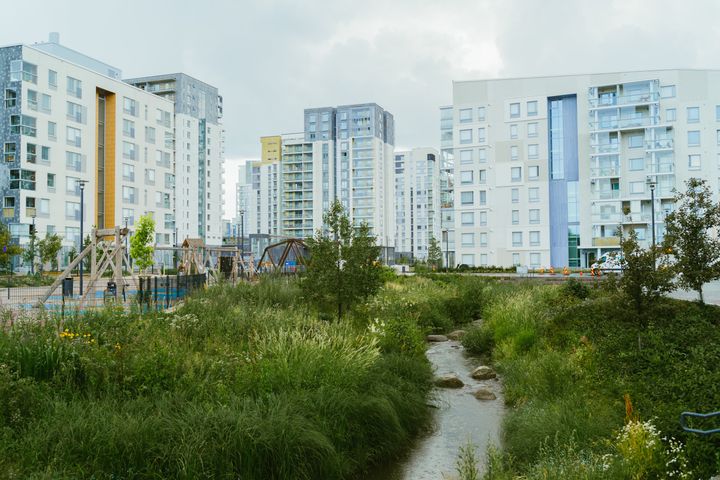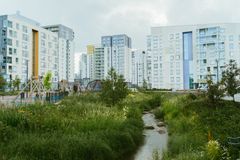Finnish municipalities have progressed to varying degrees in climate change adaptation – risks are not sufficiently assessed
The majority of Finnish municipalities have taken action to adapt to climate change. However, only less than half of the municipalities have set targets or prepared action plans for climate change adaptation, reveals a recent survey conducted by the Finnish Environment Institute (Syke).

Based on the responses, Syke assessed the situation in municipalities depending on how far they have progressed in climate change adaptation. The most advanced of the large municipalities are Espoo, Turku and Vantaa. Pirkkala, Kirkkonummi and Ylöjärvi were the most advanced of the medium-sized municipalities. Of the small municipalities, Pielavesi, Kitee, Kruunupyy, Kivijärvi and Urjala were leading the pack.
The survey was carried out in spring 2025, and 118 municipalities responded to it. These municipalities represent about 4.1 million inhabitants in total, which covers an roughly 73 per cent of the Finnish population. The survey was ordered by the insurance company If.
Climate change is visible in municipalities
Of the municipalities that responded to the survey, 87 per cent reported that climate change had been visible in the municipality. The greatest number of observations have been made on increasing precipitation, increasing temperature and changing flow rates of lakes and rivers. Only 13% of the responding municipalities reported that they had not observed any extreme weather events or impacts of climate change or could not comment.
More than 80% of the large municipalities that responded have drawn up or are preparing plans for adaptation, while the figures for small and medium-sized municipalities are 35% and 48% respectively.
Only about 10% of the responding municipalities have prepared a comprehensive assessment of how climate change can affect the municipality in the future. In this respect, Finland differs from neighbouring countries Sweden and Norway, where, according to similar surveys, the majority of municipalities have assessed climate risks and vulnerabilities comprehensively.
“Finland lacks comprehensive legislation on climate change adaptation that obliges municipalities, and regional support varies by region. In Sweden and Norway, most municipalities have carried out more in-depth risk assessments, and many have also assessed the indirect impacts of climate change. It is important to assess these, as the indirect impacts of climate change are more difficult to assess and can be as significant as the direct impacts,” says Group Manager Johan Munck af Rosenschöld from the Finnish Environment Institute.
Although the majority of the respondents reported that they have observed impacts of climate change on the municipality, only about one third of the municipalities that responded to the survey have assessed how previous extreme weather events have affected the municipality or produced baseline information or assessments of certain extreme weather events.
Adaptation engages municipalities
Almost nine out of ten of the responding municipalities reported that they are working on climate change adaptation. More than 60% of the municipalities have made a political decision to work on adaptation, and nearly two out of three municipalities have taken concrete adaptation measures. Approximately four out of five respondents said that the municipality intends to implement measures in the future.
Based on the results, just under half of the municipalities have included climate change adaptation in current municipal processes, such as local detailed planning, stormwater management, master planning, preparedness planning, water management planning and risk and vulnerability assessments.
According to the results of the survey, Finnish municipalities are clearly more likely than municipalities in Norway and Sweden to monitor their own climate change adaptation work, which supports adaptation planning and enables learning about the successes and challenges of the work.
Based on the survey, the researchers prepared a number of recommendations for climate change adaptation.
"More resources are needed. All municipalities should assess climate risks and vulnerabilities and set clear targets for climate change adaptation. Cooperation between municipal sectors and between municipalities would need to be strengthened. Communication should be developed further. Climate change affects a wide range of parties, and property owners, for example, need to be informed about various risks and responsibilities,” says Munck af Rosenschöld.
Increasing extreme weather events can be seen in the insurance sector
According to the insurance company If, which commissioned the survey, the intensification of extreme weather events is reflected in If’s countries of operation, especially in Norway and Denmark. Most recently, this autumn’s storm Amy caused extensive damage in the countries, even though it calmed down before arriving to Finland.
“We have noticed that measures are often only taken after the extreme weather event has been encountered. However, the events are unpredictable, and we are not out of their reach in Finland either, so we should also act here,” says Tia Mäki, director of compensations at If.
Although preparedness requires investments, Mäki points out that they pay for themselves. In Norway, it has been calculated that one invested Norwegian krone generates six times the savings as avoided damage costs.
“Foresight and preparedness are more cost-effective and controlled than repairing damages afterwards. It can also prevent personal injuries that can never be measured in money."
Municipality comparison (in Finnish)
Further information
Group Manager Johan Munck af Rosenschöld, the Finnish Environment Institute, tel. +358 29 525 1513, firstname.lastname@syke.fi
Head of Press Henna Nikkari, If Insurance, tel. +358 10 514 1245, firstname.lastname@if.fi
Keywords
Contacts
Media service at Finnish Environment Institute
Our Media Service provides information on research, helps journalists find experts for interviews and provides photos for media use.
Our Communication experts will answer your inquiries on weekdays from 9 am to 4 pm.
Images

Finnish Environment Institute - We build hope through research.
Finnish Environment Institute
Latokartanonkaari 11
00790 Helsinki
+358 295 251 000
It is time to move beyond solving environmental problems one by one, to systemic sustainability transformations. The Finnish Environment Institute (Syke) contributes to building a sustainable society through research, information and services. The Finnish Environment Institute is a research institute with 700 experts and researchers located in Helsinki, Oulu, Jyväskylä and Joensuu.

Subscribe to releases from Suomen ympäristökeskus
Subscribe to all the latest releases from Suomen ympäristökeskus by registering your e-mail address below. You can unsubscribe at any time.
Latest releases from Suomen ympäristökeskus
Finska kommuner har kommit olika långt i klimatanpassning – riskerna bedöms inte tillräckligt28.10.2025 06:00:00 EET | Pressmeddelande
Största delen av kommunerna i Finland har vidtagit åtgärder för att anpassa sig till klimatförändringen. Däremot har endast färre än hälften av kommunerna ställt upp mål eller utarbetat handlingsplaner för klimatanpassning, framgår det av en färsk enkät som gjorts av Finlands miljöcentral (Syke).
Suomen kuntien välillä eroja ilmastonmuutokseen sopeutumisessa - riskejä ei arvioida riittävästi28.10.2025 06:00:00 EET | Tiedote
Valtaosa Suomen kunnista on ryhtynyt toimiin ilmastonmuutokseen sopeutumiseksi. Kuitenkin vain alle puolet kunnista on asettanut tavoitteita tai laatinut toimintasuunnitelmia ilmastonmuutokseen sopeutumista varten, selviää Suomen ympäristökeskuksen (Syke) tekemästä tuoreesta kyselystä.
Suomella on vielä mahdollisuus saavuttaa hiilineutraalisuus – ratkaisevat päätökset puhtaista teknologioista ja maankäytöstä tarvitaan nyt27.10.2025 13:20:01 EET | Tiedote
Suomen ympäristökeskus, VTT, GTK ja Luonnonvarakeskus tiedottavat: Uudet pitkän aikavälin ilmastoskenaariot osoittavat, että Suomella on hyvät mahdollisuudet saavuttaa hiilineutraalisuus vuoden 2040 jälkeen ja hiilinegatiivisuus vuosisadan puoliväliin mennessä. Tavoitteeseen pääsemiseksi on lisättävä sekä teknisiä että luonnon omia hiilinieluja. VTT:n, Suomen ympäristökeskuksen, Luken ja Geologian tutkimuskeskuksen raportista selviää myös, että niin kansalaiset kuin yrityksetkin ovat erittäin sitoutuneita ilmastotavoitteiden saavuttamiseen.
Viikkokatsaus 27.–31.10.202523.10.2025 11:46:41 EEST | Tiedote
Hei! Tässä tiedoksesi meillä Suomen ympäristökeskuksessa ensi viikolla ilmestyviä tiedotteita, uutisia, kampanjoita, blogeja ja uutiskirjeitä. Mukana myös tulevia tapahtumia ja webinaareja. Jakelemme viikkokatsauksen torstaisin STT:n kautta. Koosteet löytyvät myös STT-uutishuoneesta, josta voit tilata kaikki Suomen ympäristökeskuksen tiedotteet.
Restaurering av Finlands natur är en investering i framtiden15.10.2025 07:02:00 EEST | Pressmeddelande
Finlands natur kan återhämta sig genom omfattande restaurering. Finlands miljöcentrals nya Policy Brief-publikation erbjuder rekommendationer som stöd för den nationella restaureringsplaneringen.
In our pressroom you can read all our latest releases, find our press contacts, images, documents and other relevant information about us.
Visit our pressroom